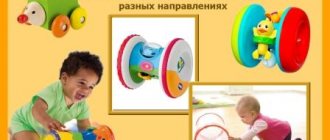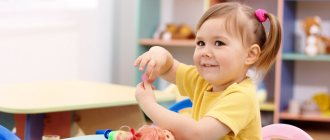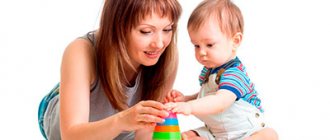What should a 12 month old baby be able to do?
The child continues to become more and more interested in the world around him, he is interested in the names of objects and communication with people. The baby is socialized, he willingly gets to know his peers and other people.
By this age, the child has learned to throw toys and objects consciously; he is interested in how far the ball will roll or the cube will fly away.
What should a 12 month old child be able to do:
- Stand on outstretched legs, walk holding onto support. Actively crawl, moving from one room to another.
- Take two small objects with one hand and be able to hand them to mother upon request. Typically, a child will use two hands to grasp a handful of small toys.
- Squat and sit down without assistance.
- Assemble a pyramid, build a tower from cubes. May spend more time alone with himself, playing or looking at colorful pictures.
- Learn new gestures: Many one-year-olds can blow a kiss, wave their arms, and blow hot air.
- Actively copy your parents’ gestures and imitate a conversation on the phone.
- Be able to hold a spoon and try to grab food with it (provided that mom has previously shown how to do this).
- Understand from 10 to 20 words, determine the name of objects that he sees every day. Show with your finger where the cat, book, plate, etc. are.
What else should a 1 year old child be able to do? At this age, the active development of the speech apparatus continues. The baby tries to pronounce some words, although they still only resemble speech. It is worth noting that one-year-old children attach several meanings to the same word.
Until the age of 1 year, the child is closely emotionally connected with his mother, perceiving her as part of himself. At the age of 12 months, the baby’s personality and character traits continue to form. At the same time, the little one is experiencing an internal conflict - the desire for independence and the habit of having his mother nearby.
Speech development of a child at the age of 12 months
By the age of 1, the child has already learned 8-10 words. A connection arises between the name of the object and the object itself - a real understanding of speech (read what it used to be here).
The child’s new needs (to demand something from an adult, to tell him something) are the impetus for the development of speech. The previous means of communication (emotional, facial, indicative) are no longer enough.
If earlier the word was a kind of addition to the gesture of pointing to the desired object, now the child needs more complex phrases, because he wants to not only take the object, but also use it somehow. There is a need for a new level of communication with adults in order to build interaction on subjects of interest.
Skills for 12 months
A child’s skills at this age are varied and can be divided into the following achievements:
Cognitive:
- Plays with a pyramid: puts on and takes off rings.
- Places cubes on top of each other.
- Imitates his peers (throws dice, claps his hands, may start breaking a toy).
- Opens and closes drawers, doors, turns everything on/off, presses buttons, etc.
Social-emotional:
- Laughs, rejoices at mom or her favorite toy.
- Shows a varied range of emotions depending on the situation: laughs, is indignant, cries.
- Shows dissatisfaction when treated rudely, if he hears “no”, “impossible”.
- Copies the facial expressions of his parents, imitates them.
- Interested in pictures in books, bright objects.
- He listens to music with interest and “sings along.”
Speech:
- Upon request, he can perform an action with a toy (give it, put it, put it in a box).
- Can pick up or show a familiar object.
- Understands the words “you can’t”, “take”, “you can”.
- Remembers the names of relatives, knows some wardrobe items.
- If they say goodbye, he waves his hand.
- He understands the game of peek-a-boo and covers his face with his palms.
Household:
- Holds a cup in his hands and drinks from it independently.
- Can bite off a cookie, an apple, a banana.
- Helps to dress himself, raises his leg.
- Some children at this age are very familiar with the potty and ask to use it, making characteristic sounds.
Child growth at 12 months - norms for boys and girls
The baby’s physical development continues actively; in a year he has grown by about 25 cm. Now, according to Russian pediatrics, the child’s height should be in the following range:
- Girls: from 71.3 to 78.1 cm.
- Boys: from 72.1 to 79.8 cm.
According to the World Health Organization (WHO), a child's growth at 1 year should be close to the following marks:
- Girls: from 68.8 to 79.3 cm.
- Boys: from 71.1 to 80.6 cm.
Baby weight at 12 months - norms for boys and girls
By this age, the baby gains 6-7 kg, subsequent weight gain will not be as active. The weight of a child at 12 months, according to domestic pediatricians, should not exceed the following marks:
- Girls: from 8.4 to 10.9 kg.
- Boys: 8.8 to 11.7 kg.
According to WHO, the weight of a child at 1 year of age should be within the following limits:
- Girls: from 7.1 to 11.6 kg.
- Boys: 7.8 to 12.1 kg.
What should a year old child be able to do?
1. Of course, the baby sits and crawls well.
2. The child stands independently. From a standing position he sits down and can stand up.
3. At 12 months the child is able to walk on his own.
The appearance of this skill is not strictly fixed for any month of life. Some children begin to walk at 10 months and are practically running by the age of one year. Babies who prefer to crawl may go later - at one year or at one year and a month. The most important thing is that the child demonstrates the development of this skill, every day trying to take one step more than yesterday.
4. The baby meaningfully pronounces a few simple words - “mom”, “dad”, “lala”, “baba” and the like. But even if this is not the case, there is no need to immediately sound the alarm.
With a taciturn child, try to communicate more, talk about the phenomena and events around. Accompany your actions with explanations and explanations, read together.
5. The child holds the mug with both hands, drinks from it himself, and puts it in its place. Trying to or already holding a spoon.
6. Builds a small tower of cubes, strings rings onto a pyramid, and turns the pages of a book.
7. Performs simple actions upon request - find a toy, take a doll, feed a bear, find a pyramid, etc.
8. Reacts to the appearance of other children.
9. Knows the names of loved ones, turns his head towards the person whose name was named.
It is natural for a 12-month-old child to show his character. Parents of such children note that the child has stopped obeying (even though he understands the word “impossible”), often persists, insists on his own, is capricious, and refuses to fulfill the requests of adults. This is due to the fact that the development of a 12-month-old child is approaching a new stage of personality development associated with the formation of will and testing the strength of one’s own boundaries. Child psychologists call this the one-year crisis.
Mental development of a child at 12 months
The child’s socialization continues actively; he is interested in communicating with peers, but sometimes he provokes conflicts. The psychological development of a child at 12 months has made great strides forward; now the baby understands how to communicate with his parents.
Feeling softness and condescension on the part of the mother, the child will play pranks and attempt manipulation.
It becomes more difficult to play with a one-year-old child; he introduces his own rules, which are often unacceptable: throwing sand, breaking toys, pulling animals by the tail.
During this period, the child begins to develop long-term memory. One-year-old children remember some moments of yesterday and can remember what happened several days ago.
Children of this age have a positive attitude towards music, love to listen to it, sing along and dance.
As mentioned earlier, at approximately 1 year the child experiences a transitional moment - the crisis of the 12th month. It is manifested by the following changes:
- The child becomes difficult to control - he shows stubbornness and disobedience.
- He actively shows his own independence, refuses help, and when trying to help he gets nervous and screams.
- The child becomes touchy and whiny, especially when he hears “no”, “no”.
- Many parents note the contradictory behavior of the child - he refuses help and at the same moment waits for attention.
According to psychologists, the age at which hysterical behavior in an infant is acceptable is 10-12 months. Firstly, the lack of vocabulary does not give the child the opportunity to explain what is bothering him. Secondly, hysteria is a common phenomenon and behavior for a child. At an older age, hysteria is not acceptable and should be stopped immediately.
Mental and intellectual development
At 1 year of age, the baby’s growth and weight gain slows down, but intellectual and emotional development becomes more intense. Longer periods of wakefulness allow the child to spend more time playing. The main ways of cognition in children at 12 months are sensory. Tactile sensations develop memory. By touching certain objects, the baby remembers their features and properties. For example, a ball is round and bounces, a car has wheels and can move, a cube is hard and can be used to build.
Height and weight at 12 months
The child remains very active and spends a lot of energy exploring the world around him, so weight gain at this age remains small: about 400 grams. Height increases within one centimeter.
The average height and weight indicators at 12 months are a weight of about ten kilograms and a height of 71 to 79 centimeters. It is worth noting that there are no exact height and weight indicators for all children at this age. Due to the characteristics of different organisms, heredity and growth conditions, changes in a child’s height and weight may vary from child to child and small discrepancies with normal indicators are not a big problem.
Psycho-emotional development at 12 months
- The baby knows and pronounces about twenty words. Typically these words include the names of objects around him, names of people or frequent events. Pronunciation is still far from perfect, but most words are not difficult to understand. A child may use some words in a distorted sense or interpret their meaning more than it really is.
- The baby gets to know and communicate with other children with interest. But you should be careful, as conflicts often occur at this age.
- The child understands the difference between adults and who treats him how. He may be more capricious and disobedient in the company of a kind mother and grandmother, and on the contrary, behave much more restrained with a strict father or grandfather.
- The child shows character in games. He comes up with new rules, tries to do everything his own way. This may make communication a little more difficult for your child.
- Long-term memory begins to develop. The child remembers everything that happened to him yesterday, three days ago or even a week later.
- The child listens to music with interest and plays to it. Some children try to sing along, others dance.
- The child continues to master humor. Now it is important for him not only to laugh himself, but also to try to make his parents laugh or please. A developed sense of humor may be a sign of high intelligence
- Can answer yes/no questions with a nod of the head, say goodbye and greet with waves of the hand. The baby also understands simple phrases when he is offered something or asked to come over.
Nutrition at 12 months
Nutrition at this age is not much different from last month. In general, at 12 months you can begin to accustom your baby to common everyday foods. However, if the baby eats at a common table, then all food should either be boiled, stewed, or steamed; it should not contain seasonings, salt or sugar. Food should be divided into small portions so that the baby can chew comfortably.
At this age, the child should also eat five times a day. Excellent options to include in your child’s diet would be low-fat soups, various cereal porridges and vegetable purees, pieces of boiled meat and wheat bread. Fermented milk products should be left for the evening; feeding homemade cottage cheese will be especially useful.
If the child has his first teeth, then chewing reflexes need to be stimulated by including small pieces of soft and well-cooked vegetables and soft fruits in lunches. You can also prepare porridge and purees not in a blender, but with a fork, allowing the child to chew small pieces of food.
Checking development rates at 12 months
One year is an important date in the development of a child, his first birthday. His development will continue to take huge steps, but it is important to understand what the baby already knows and can do, and what he needs help with. To ensure the required level of development of your baby, you can conduct a series of simple observations and tests for general physiological and intellectual development.
- The child can get up and stand, leaning on something. Some are able to take independent steps.
- The baby should use at least a couple of simple gestures.
- Pronounce and understand a few simple words.
- The baby can independently drink from his own mug and try to eat with a spoon. He should also try to copy the movements of adults, such as brushing.
- The child should be able to assemble a small tower from cubes (two or three cubes in height).
- Can identify objects by description and point to them.
Try to pay close attention to your child's behavior. The manifestation of some features may indicate slight deviations in development. Features there include the following:
- Does not actively interact with new environmental objects and toys.
- Does not respond to his own name, and also reacts slowly to annoying sounds or voices of close relatives.
- Unable to support his own weight while standing.
- Too calm
Skills at 12 months
- At this age, babies can walk holding their parents' hands or leaning on furniture. Some children begin to walk independently, but some prefer to move on all fours. There is no need to worry that the baby has not yet started walking; perhaps his body is not ready for this.
- Skillfully manipulates his hands. The child can hold several objects using either one hand or both. Can pass, take, or hold an item.
- The child is able to stand up or sit down independently, without leaning on furniture or walls.
- The baby skillfully plays with more complex toys. For example, he can build a pyramid by putting rings on a stick.
- Masters nonverbal communication skills. Gestures can be used to greet, call, thank or say goodbye. Easily learns new gestures and repeats after parents.
- Tries to eat independently using cutlery. The best option would be to purchase special cutlery made from soft and wear-resistant materials that will be comfortable for the child to use.










